 Leading Blog | Posts by Month |
 Leading Blog | Posts by Month |
03.31.12

LeadershipNow 140: March 2012 Compilation
Posted by Michael McKinney at 11:45 PM
03.30.12

The Power of Habit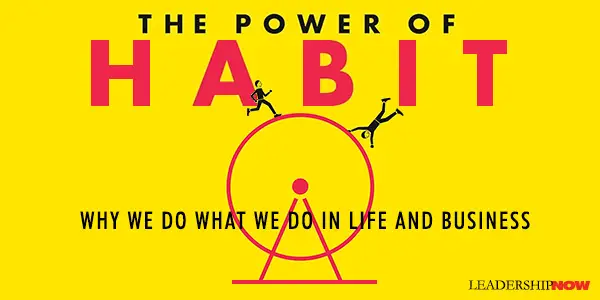
HABITS will always be with us. Some good. Some bad. But how do you replace bad habits with good habits? More importantly, how often do we ask ourselves if what we are doing is really just a habit? We are less intentional than we think we are. Charles Duhigg has written a book for all of us: The Power of Habit. After reading it you will understand how habits are formed and what you can do about it. You will also look at habits in a new way. Habits infiltrate our organizations and become invisible forces to contend with that we never realized were there. Learning to spot them is key to our success. Consider the following story:As a newspaper reporter in Baghdad, Duhigg heard about an officer conducting an impromptu habit modification program in Kufa, a small city ninety miles south of the capital. He was an army major who had analyzed videotapes of recent riots and had identified a pattern: Violence was usually preceded by a crowd of Iraqis gathering in a plaza or other open space and, over the course of several hours, growing in size. Food vendors would show up, as well as spectators. Then, someone would throw a rock or bottle, and all hell would break loose. In a sense, a community—your organization—is a giant collection of habits. Later, when Duhigg talked to the major, he said, “Understanding habits is the most important thing I’ve learned in the army.” “Once you see everything as a bunch of habits,” says Duhigg, “it’s like someone gave you a flashlight and a crowbar and you can get to work.”
The key to remember here, says Duhigg, is that “When a habit emerges, the brain stops fully participating in decision making. It stops working so hard or diverts focus to other tasks. So unless you deliberately fight a habit—unless you find new routines—the pattern will unfold automatically.” Breaking habits down in this way makes them easier to deal with. If we can learn to identify the cues and rewards, we can change the routines. We can live life a bit more intentionally. Duhigg shows how habits played a part in the success of Olympic swimmer Michael Phelps, Starbucks CEO Howard Schultz, and civil-rights hero Martin Luther King, Jr. He goes behind the scenes at Procter & Gamble, Target superstores, Rick Warren’s Saddleback Church, and NFL locker rooms. He explains how improving a single habit rippled out to improve an entire organization—Alcoa. Fascinating material to think about on many levels. How much of what you do is on autopilot? How much of what your organization does is on autopilot? 
Posted by Michael McKinney at 07:08 PM
03.26.12

YESability: Driving Growth with YesIn a world that is moving from a global economy driven by mass production to one driven by mass customization—a now economy—the demand for mass ingenuity, mass engagement, and mass action, has never been greater.In Business at the Speed of Now, author John Bernard says that there must also be a shift in the way we manage our organizations. “Centralized innovation and decision-making, the mainstays of the Mass Production era, simply cannot get results in a world where unlimited choice demands real-time response.” What is required is leadership at all levels—“one that enables employees at all levels to solve problems and seize opportunities autonomously and instantaneously.” To navigate this shift from mass production to mass customization people need the freedom to sieve every opportunity to solve problems quickly and efficiently. This requires a move from what Bernard calls “then” thinking to “now” thinking. “Then relies heavily on centralized control and specialization, whereas now relies heavily on decentralized autonomous action.” It requires a YES mindset. It means “ensuring that the people who first encounter customer problems possess the tools, skills, information, and authority they need to say yes now—YESability. YESability doesn’t mean anarchy. Bernard explains, “Replacing no with yes does not mean that from now on you give everyone permission to do whatever they want. You draw clear boundaries to establish order, and you provide language and methods people can use to solve problems. You become an enabler of action rather than an unwitting obstacle to performance.” Every employee must be provided with five crucial elements:

Posted by Michael McKinney at 11:47 PM
03.22.12

5 Leadership Lessons: Leading Any Team to Success Fistitude is a fable about a basketball team at a small private high school that is struggling through a rough season. The coach must take a leave and it is up to the interim coach to try to turn things around. Through Fistitude—each finger representing a success attitude—author Sean Glaze presents five lessons to build leaders and teamwork. Glaze illustrates that leadership is taking personal responsibility for what happens, holding yourself accountable and setting an example for others. Here, described in brief are five success attitudes:
Posted by Michael McKinney at 07:54 AM
03.20.12

The Four Disciplines of Organizational Health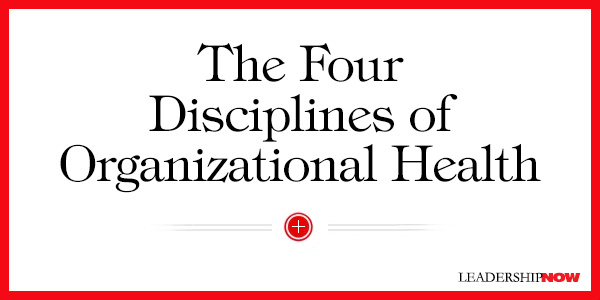
PATRICK LENCIONI believes that the single greatest advantage any company can achieve is organizational health. Unfortunately most leaders prefer to deal with the data-driven world of organizational intelligence. The problem is, without good organizational health, organizational intelligence is attenuated. In The Advantage, Lencioni explains that “an organization is healthy when it’s whole, consistent and complete, when its management, operations, strategy and culture fit together and make sense. You know you have it when you have minimal politics and confusion, high degrees of morale and productivity, and very low turnover among good employees.” Additionally, the value of a healthy organization has a ripple effect that affects all who come into contact with it or its employees. What does an organization have to do to become healthy? Creating a healthy organization is a rigorous endeavor. Lencioni has created a four disciplines model: Discipline 1: Build a Cohesive Leadership Team
Discipline 2: Create Clarity In addition to being behaviorally cohesive, the leadership team of a healthy organization must be intellectually aligned and committed to the same answers to six simple by critical questions:
There can be no daylight between leaders around these fundamental issues. Discipline 3: Over-communicate Clarity Once a leadership team has established behavioral cohesion and created clarity around the answers to those questions, it must then communicate those answers to employees clearly, repeatedly, enthusiastically and repeatedly (that’s not a typo). When it comes to reinforcing clarity, there is no such thing as too much communication. As tempting as it may be, leaders must not abdicate or delegate responsibility for community and reinforcement of clarity. Instead, they have to play the tireless role of ensuring that employees throughout the organization are continually and repeatedly reminded about what is important. Discipline 4: Reinforce Clarity Finally, in order for an organization to remain healthy over time, its leaders must establish a few critical, non-bureaucratic systems to reinforce clarity in every process—hiring, managing performance, rewards and recognition, employee dismissal—that involves people. These disciplines may sound idealistic—and they are—but health is a matter of degrees. Any improvement will reap benefits. There will always be those that use "idealism" as an excuse to not make the effort; to find this all too remarkable to actually implement. Not surprisingly, the key is leadership. But it is a sacrifice. If an organization is to get healthy, it must have the “genuine and active involvement of the person in charge. For a company, that’s the CEO. For a small business, it’s the owner. For the school, it’s the principal. For the church, it’s the pastor. For a department within a company, it’s the department head….The leader must be out front, not as a cheerleader or a figurehead, but as an active, tenacious driver.” Without the leader's commitment, this model will be sabotaged or seen as “career suicide.” The leader must support it and reward it. 
Posted by Michael McKinney at 07:57 AM
03.19.12

Being Smart is Not Enough
BEING SMART has become a commodity. It's permission to play, says Patrick Lencioni. He writes in The Advantage: In this world of ubiquitous information and nanosecond technology exchange, it’s harder than it has ever been in history to maintain a competitive advantage based on intelligence or knowledge…..I have become absolutely convinced that the seminal difference between successful companies and mediocre or unsuccessful ones has little to do with what they know or how smart they are; it has everything to do with how healthy they are. He reasons that healthy organizations can get smart over time as they are quick to learn from experience and each other, but smart organizations don’t necessarily get healthier by virtue of their intelligence. In fact, it often stands in their way as they are not as open to learning. “The key ingredient for improvement and success,” writes Lencioni, “is not access to knowledge or resources, as helpful as those things may be. It’s really about the health of the environment.” Healthy organizations are able to tap into more of their collective knowledge and use it. “Most organizations exploit only a fraction of the knowledge, experience, and intellectual capital that is available to them. But the healthy ones tap into almost all of it.” In short, what Lencioni is talking about is a component of humility: teachability. Teachability plays a huge role in determining the health and consequently the success of an organization. Unhealthy organizations are hindered by politics, confusion, and low morale, resulting in low productivity and high turnover. Next time we’ll look at what an organization has to do to become healthy.

Posted by Michael McKinney at 12:02 AM
03.17.12

Keep Calm and Carry On
Stuart and Mary Manley are proprietors of one of the most beautiful secondhand bookstores anywhere—Barter Books—in the northeast corner of Northumberland, England. After being forgotten for more than 70 years, they rediscovered, in a box of old books bought at auction, a rare original of the now famous WWII poster Keep Calm and Carry On. Produced more than 70 years ago, this poster was one of three propaganda posters produced by the British government in the spring of 1939 in the build up to World War II. To be used in a time of crisis or invasion, this poster was never officially issued to the public. All of the posters were printed in two colors, using a “special and handsome” typeface, which would be difficult for Germany to counterfeit, along with the crown of King George VI as the only graphic device. 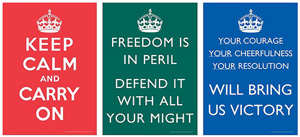
Posted by Michael McKinney at 09:46 PM
03.14.12

Develop a Relentless Solution FocusWhatever you are trying to accomplish, Jason Selk, author of Executive Toughness, says a relentless solution focus (RSF) will dramatically increase your chances of achieving it.The tactic is this: Within 60-seconds, replace all problem focused thought with solution-focused thinking to dramatically improve your health, happiness, and success. We naturally like to focus on and talk about our problems. “We all have the tendency to take the positive for granted. We allow it to become the faint background for the problems we draw in intricate, larger-than-life detail.” A focus on problems only produces more problems. Your mind can only focus on one thing at a time—better to have it focusing on solutions than problems. “Anytime you catch yourself focusing on a problem, negativity, or self doubt, as yourself this question: What is the one thing I can do differently that could make this situation better?” Any solution, even a partial one will begin to stop the negative emotions. “To ensure you have the necessary perseverance to continue searching for the viable solution, you must first realize that each and every problem has a solution. There’s always a +1 solution that brings you one step closer to a full solution. Most people want a solution that produces complete resolution to the problem….Any improvement, small or large, is a solution: a +1 solution to be precise.” Selk, mental toughness is the ability to focus on and execute solutions, especially in the face of adversity. It is built on three skills: developing accountability (consistently doing what needs to be done), increasing focus, and becoming optimistic (confident in one’s abilities). Selk was inspired by coach John Wooden and his belief in trusting the process; “give me those things that I know you can give me and I will take whatever comes.” Executive Toughness explains how to develop mental toughness through the daily practice of ten fundamentals. 
Posted by Michael McKinney at 11:01 PM
03.12.12

The 11 Essential Elements Needed to Achieve True Collaboration
DAN SANKER states that ironically, in order to remain “competitive” companies will have to become more collaborative. Collaborate: The Art of We is a practical guide to going beyond democratic or cooperative work to creating truly collaborative work environments as a growth strategy. Collaboration is not a new concept, but globalization and new technologies have turned it into one of the best methods of competitive advantage available. Rather than engaging in an endless tug-of-war over the dwindling crumbs in a finite market, collaborative companies find ways to make the pie bigger, or create whole new pies, expanding everyone’s market and revenue. “It’s not about how many people you can defeat, but rather about how many people you can help win.” Although networking, coordination, and cooperation may look like collaboration, they are not. True collaboration is the “synergistic relationship formed when two or more entities working together produce something much greater than the sum of their individual abilities and contributions.” It results in something that did not exist before. The focus is on results and not process. Collaboration is distinct from cooperation in that “although both cooperating parties may achieve a common goal, they do not necessarily enhance each other’s capacity. In addition, cooperating parties do not fully share risks, responsibilities, and rewards. In the case of collaboration, all available resources, as well as risks, responsibilities, and rewards, are fully shared.” For a collaboration to be successful, Sanker says that eleven elements must come together: Ongoing Communication. People need to be able to talk to one another freely and regularly. Groups that do not have this kind of interaction are nothing more than loose collections of individuals working on their own tasks, toward their own ends. Willing Participation. Everyone believes that they are working toward the same, mutually beneficial goal and that each one of them will have gained something valuable when that goal has been achieved. Brainstorming. It’s the creative part of the collaboration process, in which members of the group move beyond the “same kind of thinking” to come up with new ideas that bring true value to the collaborative effort. Teamwork. It’s teamwork that keeps people with a diverse set of skills, knowledge, information, and perspectives working together effectively and efficiently to achieve their common goal. A Common Purpose. If the group moves forward too quickly without taking the time to clarify their goal and make sure that everyone is in agreement about what it is, they will undoubtedly run into huge disagreements that are likely to tear the effort apart. Trust. You need to feel confident that other people in the group are putting the group’s shared goal—not their own interests—first, and that they will keep confidential or sensitive information within the group, take you seriously, respect your point of view, and not take credit for your ideas. A Plan for Achieving the Goal. Everyone needs to be working from the same script, clearly understanding roles and responsibilities, and they need to have the same understanding of what success looks like. A Diverse Group. Diversity is the power behind collaboration. Without diversity groupthink sets in. It is diversity that gives a team the unique perspectives needed to create truly innovative solutions. Mutual Respect. For collaboration to be successful, team members must encourage, listen to, and seriously consider all of the ideas suggested by others in the group, no matter how unworkable they might seem. A Written Agreement. A written agreement helps the group avoid misunderstandings and lack of clarity that could derail the process after everyone has invested a great deal of time, effort, and resources. Effective Leadership. Whether one person has been formally designated as the leader of the group is self-led, leadership of some sort is essential to keep the group focused on its destination and facilitating the process of getting there. 
Posted by Michael McKinney at 11:33 PM
03.09.12

Hiring for Attitude
“Most new hires do not fail on the job due to lack of skill,” says Mark Murphy. Attitude is a bigger issue than skill. Consequently, most of our approaches to selecting the right people for the job are dead wrong. In Hiring for Attitude, Murphy lists the top five reasons why new hires failed:
What attitudes work in one culture may not work in another. Attitudes are culture specific. So you first need to discover your organization’s unique attitudes. Think about the “attitudes that separate your high performers from your middle performers and your low performers from everybody else. You’re not trying to create a laundry list of attitudes but just the—three to seven—“important critical predictors of employee success or failure for your organization.” Murphy talks about the kinds of common questions you should never ask—the “tell me about yourself” questions, the behavioral “tell me about a time when” questions, the hypothetical “what would you do if” questions, and the oddball “if you could be any superhero” questions—and how to create the questions and evaluate the answers that differentiate people by the attitudes that are the most important to success in your organization. A benefit of determining the attitudes that work best in your organization is that you can begin to clearly communicate those attitudes to your current employees and develop high performers throughout the whole organization.   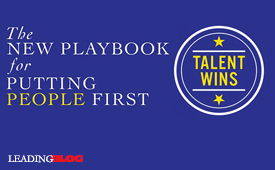
Posted by Michael McKinney at 04:42 PM
03.07.12

8 Essential Principles of Effective LeadershipGayle Beebe has written a book on how effective and moral leaders develop and more importantly, how they must continue to develop. Too often leaders think they have made it and stop working on themselves. Eventually they become leaders in title only. He writes in The Shaping of an Effective Leader:Our understanding of leadership does not come to us all at once. It takes time. In our instant-oriented culture we often want to short-circuit the thinking, reflecting and acting that mark our progressive development as leaders. Understanding how leaders develop and why they matter requires discernment, wisdom and insight.Leadership development is a process. Seeking instant results and ladder-climbing can leave us little to show for our efforts. Some leaders “penchant for moving on has allowed them to avoid facing the consequences of their decisions” thereby restricting their development. “They have changed responsibility so often that they have failed to undergo the development that comes from facing mistakes.” Then too, some leaders are so busy “fixing problems” with personnel changes that they never really face the core issue—themselves. Beebe draws heavily on Peter Drucker’s teachings and writings. The implementation of these eight principles will have a profound impact on your leadership: The Necessity of Character. “The formation of our character creates predictability to our leadership. Predictability, dependability and consistency: these three qualities ensure that our leadership is reliable and motivates people to place their confidence in us.” The Importance of Competence. “Drucker emphasized the importance of a liberal arts education, which he believed was the best training for learning how to synthesize discrete pieces of information into a meaningful whole….All knowledge must be brought to bear on our challenges.” The Advantage of Team Chemistry. Generosity builds teams. Greed destroys them. “Eventually it leads to a lack of respect for the needs and ambitions of others because our own needs and ambitions overrun all normal boundaries and expectations….It is made manifest by an excessive need for acclaim, attention or compensation. It also is evident in an inability to share the limelight. Malice and thoughtlessness are twin manifestations of this same inner drive.” The Interplay of Culture and Context. Cultures shape people. “An appropriate structure (culture) is the one best suited to maximize the performance of our people.” In addition, “culture is also shaped and influenced by the environmental context in which it exists….One of the biggest mistakes a company can make...is when it operates on the basis of what it prefers and how it believes a society should function, rather than how the society actually operates.” The Strength of Compatibility and Coherence. “We have to know ourselves well enough and understand ourselves deeply enough to enter into the kind of human communities that will sustain us.” The Guidance of Convictions. “An individual must balance a strong self-understanding and self-esteem with the necessity of confronting all issues both objectively and subjectively….A self-differentiated leader is one who has a head (intellectual capacity) from which he speaks with conviction while having a heart (empathetic capacity) with which he stays connected to people.” The Significance of Maintaining Our Connections. “Remaining connected to our work associates even when we make hard decisions is only possible if we maintain personal integrity, display competence, create team chemistry, develop a great culture, retain a level of compatibility that motivates, and display a level of conviction and predictability that people trust.” The Opportunity to Make an Ultimate Contribution. The ultimate contribution is in our quest for meaning. “Work, meaningful as it may be, can lose its appeal….Drucker advocated developing a second interest long before we exhaust our first interest. This parallel career becomes not only our lifeblood for meaningful work and service opportunities in the future, but also a source of great support if we were to experience major setbacks in the present.” Beebe writes, “These principles do not operate separately from one another. Indeed, they build on each other, and their effect is cumulative.” These eight principles will improve our contribution as leaders if we are mindful of them on a daily basis throughout the rest of our lives. At each level our character is tested and developed. Effective leadership is built on moral authority grounded in character. Leadership is a privilege that we earn every day. 
Posted by Michael McKinney at 10:36 PM
03.02.12

Eisenhower, Kennedy & the Power of Vision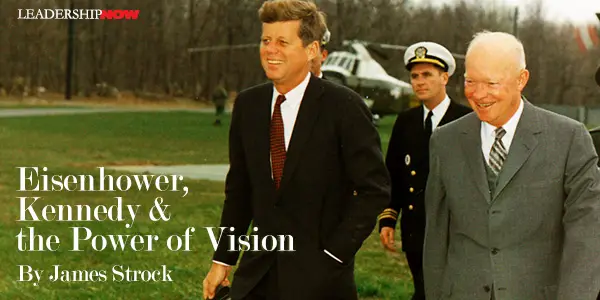
Serve to Lead, my book about 21st century leadership, includes respectful references to the management approach of Dwight Eisenhower. Some readers, I learned, had been unaware of the scope of Ike’s accomplishments. Some young people have scarcely heard of the thirty-fourth president. By contrast, many more people are aware of the leadership of John Kennedy, Ike’s successor. JFK is routinely ranked among the presidents most admired by Americans today. There may be lessons in the differing public understandings. Eisenhower Accomplishments Overlooked 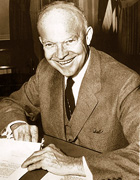 More recently, Ike has been rediscovered. In his new book, Eisenhower in War and Peace, respected historian Jean Edward Smith makes the case for Eisenhower’s exceptional leadership in war and politics. Ike: Civil Rights, Space The Eisenhower administration broke ground in the long-overdue struggle to accord African-American civil rights. Examples cited by Smith include:
So, too, he initiated the American space program, establishing the National Aeronautics and Space Administration in response to the Soviet Union’s successful Sputnik launch. And yet… how many Americans today recall Eisenhower’s decisive role in civil rights or the space program? JFK: Civil Rights, Space By contrast, John Kennedy is indelibly identified with each. It is impossible to know what Kennedy might have accomplished in the civil rights arena, had his life not been tragically truncated. As it was, his administration’s accomplishments were limited. In significant part this was because of his party’s reliance on the “Solid South,” and the conservative, rural coalition that held great sway in the Congress. JFK did convey public support at key moments. One was his celebrated telephone call of support to Mrs. Coretta Scott King, following the jailing of Dr. Martin Luther King, Jr. during the 1960 campaign. Most memorable was Kennedy’s June 11, 1963 speech on civil rights. He brought the American past, present, and future together, declaring: The heart of the question is whether all Americans are to be afforded equal rights and equal opportunities, whether we are going to treat our fellow Americans as we want to be treated. If an American, because his skin is dark, cannot eat lunch in a restaurant open to the public, if he cannot send his children to the best public school available, if he cannot vote for the public officials who will represent him, if, in short, he cannot enjoy the full and free life which all of us want, then who among us would be content to have the color of his skin changed and stand in his place? Who among us would then be content with the counsels of patience and delay? King was moved to dispatch a telegram in response, calling the speech “one of the most eloquent, profound and unequivocal pleas for justice and freedom of all men ever made by any president.” It is hard to imagine Eisenhower evoking such a response, despite the clear direction of his civil rights policies, and his personal expressions of commitment in various settings. So, too, JFK reframed the space race, urging the American nation to “commit itself to achieving the goal, before this decade is out, of landing a man on the moon and returning him safely to earth.” This extraordinary stretch goal was achieved, with the entire world witnessing it on television, on July 20, 1969. Though Eisenhower set the stage for the moon shot, it is difficult to imagine his casting such a vision, setting off such a mission. The Power of Vision Dwight Eisenhower was, fundamentally, a military man. In many ways, his presidency represented the best of the armed forces. Ike was publicly modest, chastened by the keen awareness of war and fateful decisions. He was down-to-earth, focused intently on results. His manner of communication was skilled yet unpretentious. He was not eloquent per se, other than in the sense that his presence lent eloquence to his statements and sentiments. 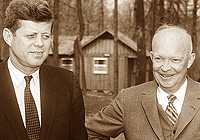 John Kennedy was a man of history and words. He was a skilled writer. He undertook to make himself a great speaker. Where Eisenhower sought to inform, Kennedy sought to inspire. His ennobling vision, evidenced in the civil rights and space examples, created its own power. He would lead first, with management harnessed to serve its ends. Had Kennedy fully appreciated Eisenhower’s deft management of large enterprises, he might well have avoided early missteps, such as the Bay of Pigs invasion. Had Eisenhower had Kennedy’s skill with vision and communication, he might well be remembered more passionately, his achievements more clearly recognized. From a distance, one might say that Eisenhower’s and Kennedy’s strengths as leaders were paired with their weak spots. Perhaps. Yet that need not stop up from striving to learn from both of their examples at their best, just they studied and learned from others. 
Posted by Michael McKinney at 02:35 PM
03.01.12

First Look: Leadership Books for March 2012Here's a look at some of the best leadership books to be released in March.




For bulk orders call 1-800-423-8273  Build your leadership library with these specials on over 120 titles. All titles are at least 40% off the list price and are available only in limited quantities. “Have given up reading books; I find it takes my mind off myself.” — Oscar Levant
Posted by Michael McKinney at 12:03 AM
|
BUILD YOUR KNOWLEDGE


How to Do Your Start-Up Right STRAIGHT TALK FOR START-UPS 
Grow Your Leadership Skills NEW AND UPCOMING LEADERSHIP BOOKS 
Leadership Minute BITE-SIZE CONCEPTS YOU CAN CHEW ON 
Classic Leadership Books BOOKS TO READ BEFORE YOU LEAD |
|